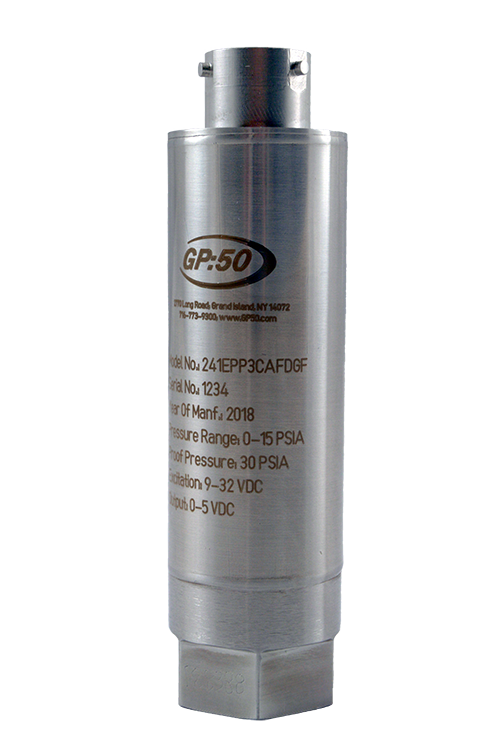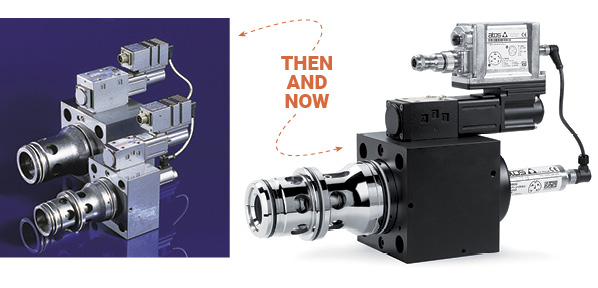No Pressure: Finding the Right Transducer for Your Hydraulic System

By Bob Atwood, Vice President and Chief Operating Officer, GP:50.
Many hydraulic or pneumatic systems require continual feedback of system pressure to ensure the system operates well and within its parameters. Many systems require the pressure sensor to either collect data, control the process, or provide critical feedback for safety reasons.
Depending on the type of system and requirements, special options, features, or design criteria may be required from the pressure transducer manufacturer. Some critical systems require that the pressure transducer go through special testing or verification at the time it is built to provide a highly reliable unit. Some require custom-built designs specific to the application, while some only require an off-the-shelf general-purpose unit to provide basic feedback in the system.
While pressure transducers are designed to measure pressure and provide an output signal, they are not all constructed the same. With many application factors to consider, it’s critical to convey potential extreme conditions when selecting a pressure transducer. Here are some areas to consider.
 Pressure pulsation. Pressure spikes are common in hydraulic applications. Spikes can occur when an inline valve opens and closes rapidly, or when a pump turns on and off and sends a high-pressure pulse that can exceed the sensor’s upper limit, damaging the sensor. Some of these pulses are so rapid they exceed the frequency response of the sensor’s electronics and are not visible in the output signal. But they can mechanically damage the sensing diaphragm. It’s not uncommon in some hydraulic systems to see pressure spikes two to three times beyond the system’s typical operating range. Due to the compressibility of a gas, pressure spike issues in pneumatic systems are less likely.
Pressure pulsation. Pressure spikes are common in hydraulic applications. Spikes can occur when an inline valve opens and closes rapidly, or when a pump turns on and off and sends a high-pressure pulse that can exceed the sensor’s upper limit, damaging the sensor. Some of these pulses are so rapid they exceed the frequency response of the sensor’s electronics and are not visible in the output signal. But they can mechanically damage the sensing diaphragm. It’s not uncommon in some hydraulic systems to see pressure spikes two to three times beyond the system’s typical operating range. Due to the compressibility of a gas, pressure spike issues in pneumatic systems are less likely.
It is important to know if this is a potential issue for your system when specifying a transducer. Special pressure snubbers that mechanically dampen the pulsations are available as well as options to increase the proof pressure, which will help improve longevity. Even installation techniques like mounting the transducer at the end of a length of high-pressure rubber hose can dampen high-pressure pulsations.
Amplitude and frequency levels. Pressure transducers have an active sensing element that deflects under pressure and provides an electrical signal in ratio to the applied pressure. This mechanical portion of the sensor has a cycle life expectancy. While most sensors are rated to many millions of cycles, the amplitude of the pressure and the frequency rate can influence life expectancy. Regarding amplitude, if the application repeatedly cycles the sensor from zero pressure to maximum full-scale pressure, this has a greater effect on its life expectancy than if the sensor was held at an elevated pressure or only cycled to a smaller percentage of the full range. If the pressure delta between the low and high pressure is small, you can typically expect longer service life and may only require a standard off-the-shelf product.
Pressure frequency also affects the life expectancy. For example, if the unit cycled 100 times an hour versus 1,000 times a minute, it could have a significant impact on the unit’s life. Combined high-amplitude and high-frequency pressure cycles affect the unit’s life.
Presenting these characteristics to the transducer supplier helps them provide the best product for the application. In severe high-amplitude, high-frequency applications there are options to provide more rugged sensors with better longevity.
Shock and vibration levels. Shock and vibration levels can also have a severe effect on the longevity of a pressure transducer. Where and how the transducer is mounted in the system can improve these potential issues. Vibration from mechanical pumps can produce frequencies that damage a transducer’s electronics. Isolating or moving the transducer away from the pump can reduce harmful frequencies. Considering this potential issue before purchasing a sensor can be the difference between a unit lasting a few months or many years.
Some companies offer transducers that provide additional internal strain relief techniques for applications where it is not possible to isolate the transducer from the pump or where high shock and vibration are present. Adding additional epoxy or strain relief to specific internal components helps eliminate breakage in these severe events. Some companies even offer more robust sensor designs as an option.
While some of these options may increase the unit’s cost, the payback comes in longer life and less downtime. Providing potential shock and vibration-level information when specifying a unit helps provide the best options for your application.
Chemical compatibility. Some fluids used in hydraulic applications may present compatibility issues with commonly used sensor materials. Even slight material incompatibilities can cause instability or drift issues over a short period of time. Some chemicals may etch a sensor’s active diaphragm and cause an increase in output or constant drift. While most sensors are made from either 316 SST or 17-4 PH SST, there are other options available. Metals such as Inconel, Hastelloy, Monel, or titanium may provide better compatibility. Defining the media to which the transducer will be exposed when selecting a device helps improve the overall life, provides for a more accurate pressure measurement, and eliminates the chance of any catastrophic failures.
Temperature. Extremely high or low process or ambient temperatures can cause poor readings or even premature failures. Providing a supplier with minimum and maximum operating temperatures allows the manufacturer to customize a sensor to function more accurately over the operating range of the application.
Higher temperatures may cause the transducer sensor or electronics to fail. While many sensors are rated 250°F to 350°F (121°C to 175°C), the internal electronics many only be rated to no more than 250°F (121°C). Exceeding this operating temperature can result in drift, inaccurate readings, and cause the unit to fail. In cryogenic applications, there are sensors rated to -320°F (-196°C), but most signal conditioners operate down to -65°F (-54°C). In both high-temperature and cryogenic applications, some suppliers offer a signal conditioner that is mounted remotely, away from the sensor and process temperature. As long as the ambient temperatures do not exceed the electronics operating temperature range and the process temperature is within the sensor’s operating range, a signal conditioner provides an accurate and reliable pressure measurement with an amplified output. It is always important to ask the factory which model is rated best for extreme temperature applications.
Environmental conditions. Hydraulic systems are often not the cleanest of environments. Oil, water, or other chemicals can splash or wash over the system’s transducer. These wet conditions may penetrate the transducer housing and cause complete failure. If a transducer is exposed to high moisture, including washdown conditions, a completely hermetically sealed design may be needed. However, many low-pressure-range transducers (typically less than 1,000 psi) require an atmospheric reference port to account for barometric changes or altitude. This reference port provides a stable and accurate pressure measurement regardless of the atmospheric pressure or altitude. If a lower range application has the potential to get the transducer wet from external fluid exposure, a vented electrical cable option can prevent water intrusion and still provide a barometric reference. For applications in mild washdown, splashing, or rain exposure, some companies provide a hydrophobic vent in the transducer body, which allows the unit to breathe but keeps moisture out. To help provide the right configuration, knowing the system’s environmental conditions is critical when specifying a product.
Electrical issues. For applications with high-power, high-voltage motors running close by, EMI or RFI immunity is critical to provide a clean usable signal. If there are potential or known electrical noise issues, many transducer manufactures offer extra filtering or protection from this extraneous noise. The internal filtering cancels out these external noises and helps provide a much cleaner signal. In outdoor applications where the threat of lightning is present, high-voltage surge suppression may also be needed. Some companies also offer internal surge suppression as well as optional external in-line surge suppression that helps alleviate failures due to a lightning strike.
There are many factors that can affect a transducer’s life expectancy. Providing all the information about your application at the time of selection results in a more reliable and accurate device and reduces the chance of a failure. Conveying these specifications when selecting a product increases the likelihood of a reliable and accurate device.






